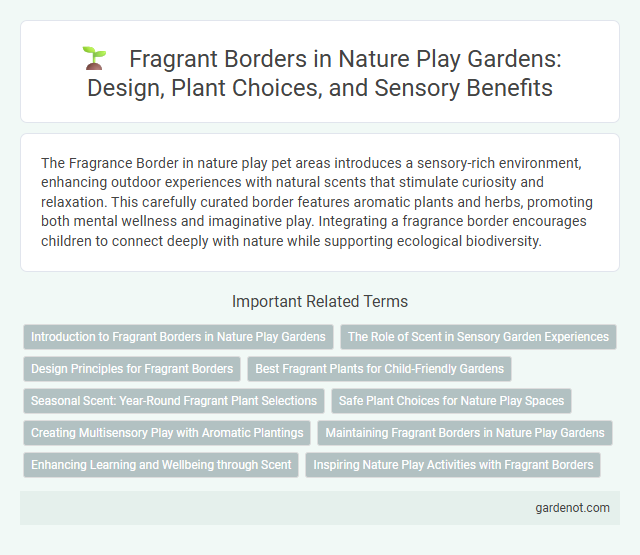The Fragrance Border in nature play pet areas introduces a sensory-rich environment, enhancing outdoor experiences with natural scents that stimulate curiosity and relaxation. This carefully curated border features aromatic plants and herbs, promoting both mental wellness and imaginative play. Integrating a fragrance border encourages children to connect deeply with nature while supporting ecological biodiversity.
Introduction to Fragrant Borders in Nature Play Gardens
Fragrance borders in nature play gardens feature carefully selected aromatic plants that stimulate sensory engagement and enhance outdoor experiences. These borders include herbs like lavender, rosemary, and mint, which attract pollinators while providing natural scents that encourage exploration and mindfulness. Incorporating fragrant plants supports cognitive development and emotional well-being by connecting children with nature's diverse olfactory landscape.
The Role of Scent in Sensory Garden Experiences
Fragrance borders enhance sensory garden experiences by engaging the olfactory senses, creating a multi-dimensional interaction with nature. Plants like lavender, rosemary, and jasmine emit distinctive scents that stimulate memory, relaxation, and curiosity in children. Incorporating aromatic flora in nature play areas fosters emotional well-being and deepens sensory exploration through natural fragrance immersion.
Design Principles for Fragrant Borders
Design principles for fragrant borders center on selecting diverse, seasonal, and native plant species that provide continuous aromatic interest throughout the year. Incorporating layers of varying heights and textures enhances sensory engagement while ensuring accessibility for all ages and abilities. Strategic placement near pathways maximizes olfactory impact, creating immersive nature play experiences that stimulate curiosity and relaxation.
Best Fragrant Plants for Child-Friendly Gardens
Fragrance borders enhance child-friendly gardens by incorporating the best fragrant plants such as lavender, jasmine, and sweet alyssum, which are known for their safe, soothing scents and non-toxic properties. These plants not only provide sensory stimulation but also promote outdoor exploration and calmness in young children. Selecting species that are both hardy and low-maintenance ensures a durable, enjoyable garden experience suitable for active play areas.
Seasonal Scent: Year-Round Fragrant Plant Selections
Seasonal scent in nature play is enhanced by selecting year-round fragrant plants such as lavender, rosemary, and jasmine, which release captivating aromas throughout each season. Incorporating a fragrance border with diverse plant species ensures consistent sensory stimulation, promoting engagement and mindfulness in outdoor play areas. Strategic arrangement of these aromatic plants supports ecological benefits while enriching the natural play environment with dynamic, evolving scents.
Safe Plant Choices for Nature Play Spaces
Selecting safe plant species such as lavender, rosemary, and chamomile enhances fragrance borders in nature play spaces by providing natural aromas without toxic risks. Incorporating non-toxic, hypoallergenic plants ensures children's safety while encouraging sensory exploration and emotional well-being. Avoiding poisonous plants like oleander and foxglove reduces health hazards, fostering a secure environment for interactive outdoor learning and play.
Creating Multisensory Play with Aromatic Plantings
Fragrance borders enhance multisensory play by integrating aromatic plantings such as lavender, rosemary, and mint, creating an engaging olfactory experience for children. These sensory-rich gardens stimulate cognitive development and emotional well-being while encouraging exploration and imaginative play. Incorporating diverse scents supports sensory integration and fosters a deeper connection to nature in outdoor learning environments.
Maintaining Fragrant Borders in Nature Play Gardens
Maintaining fragrant borders in nature play gardens enhances sensory experiences by incorporating native aromatic plants such as lavender, rosemary, and mint. Regular pruning and soil enrichment support plant health and sustain strong scents throughout seasons. Integrating fragrant borders also encourages pollinators, contributing to biodiversity and ecological balance within the garden space.
Enhancing Learning and Wellbeing through Scent
Fragrance borders in nature play areas stimulate cognitive development and emotional wellbeing by engaging the olfactory senses with natural scents like lavender, rosemary, and mint. These aromatic plants create sensory-rich environments that improve focus, reduce stress, and foster a deeper connection with nature. Incorporating diverse fragrant species within play spaces supports experiential learning and holistic health outcomes for children.
Inspiring Nature Play Activities with Fragrant Borders
Fragrant borders featuring lavender, rosemary, and mint plants create sensory-rich environments that encourage children to explore and engage with nature through touch and smell. Incorporating aromatic herbs into play areas promotes imaginative games, sensory walks, and educational activities about plant life and natural ecosystems. These fragrant borders enhance outdoor play spaces by stimulating curiosity and fostering a deeper connection to the environment.
Fragrance border Infographic

 gardenot.com
gardenot.com